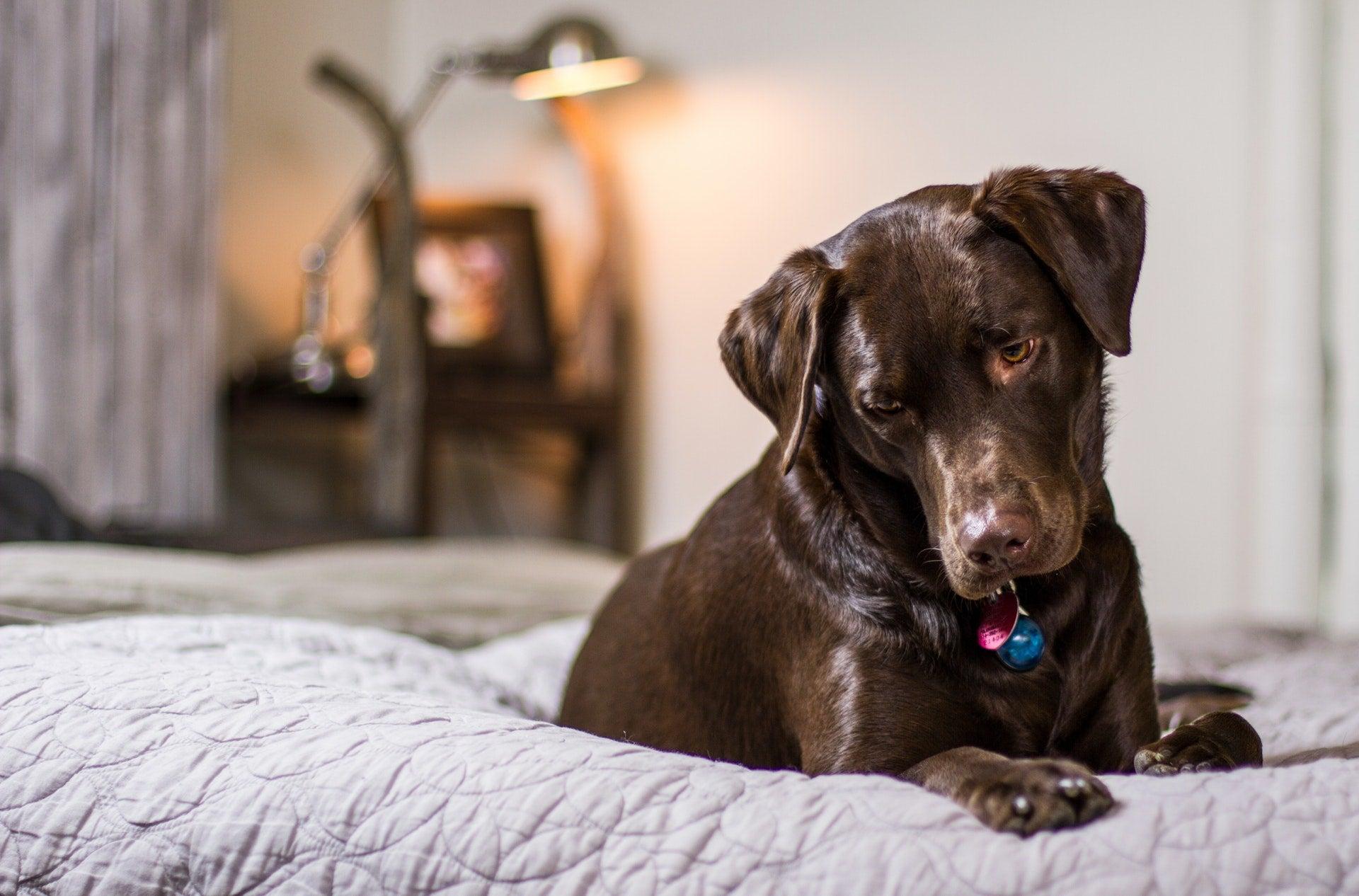Summary: Dog has fleas? Don’t worry, pet parents! In this blog, we explore 8 proven ways to support your pet with fleas and take care of your home… Fleas on your dog can appear even in the cleanest of homes and on the cleanest pets. In certain climates, fleas thrive, which means ensuring prevention […]
- Home/
- Dog/
- Health & Wellness/
- Dog Has Fleas? Here’s What To Do
Dog Has Fleas? Here’s What To Do

Summary: Dog has fleas? Don’t worry, pet parents! In this blog, we explore 8 proven ways to support your pet with fleas and take care of your home…
Fleas on your dog can appear even in the cleanest of homes and on the cleanest pets. In certain climates, fleas thrive, which means ensuring prevention is essential to undertake as a pet parent.
Fleas prefer warmer temperatures, so the summer months are when you’re more likely to see a house infestation of fleas – or in winter if you’re one to have the central heating on high.
Keeping your home safe of the pests will keep your pets happier, as fleas can cause itching and discomfort for any pet!
What Are Fleas?
Fleas are tiny insects that live on animals’ skin and feed on the blood of those animals. Their mouths have spikes that can pierce the skin and suck blood and hook themselves onto the animal. While they suck, they are also regurgitating saliva and blood (lovely!), which can transmit infections and diseases!
Fleas can leap around and between animals that they come across, making them extremely contagious. They can actually jump up to 100 times their own body length! As they are capable of spreading diseases, this makes the presence of fleas perilous!
The pesky parasites can live on pets for up to 100 days, and a female flea can lay up to 50 eggs per day. So, the prevention of a flea infestation is essential, because once it starts, they can spread like wildfire!
Fleas tend to be found nestling most often in the head, neck, ears, and feet, so check these parts of your cat or dog’s fur and skin! Keep reading to find out how best to prevent and treat a flea infestation in your home, to keep your pet free from discomfort and potential disease!
Flea Infestation On Dog? Here’s What To Do…
Vacuum Your House Regularly

You should be vacuuming around the house at least once a week, especially in the rooms that your dog has access to. It’s one of the best ways to keep a flea infestation away. Be thorough in areas where your dog or cat sleeps, such as their bed or sofas, and also pay attention to carpets, rugs, upholstered furniture, and skirting boards.
If you know your pet is prone to fleas, it’s worth vacuuming at least twice a week. Once you’ve vacuumed every appropriate area, make sure you empty the bag or container from the vacuum, because fleas can escape them and find somewhere in your house to cozy up again!
Wash Bedding and Other Common Areas
Making sure you keep your pet’s bed clean is an important way to keep your pal free of fleas. Vacuuming their bed isn’t always enough to keep the pests at bay. You should regularly wash your pup’s bed and any other areas they tend to sit or lie in, such as certain rugs, blankets, or couches if the cover is easy to remove. Wash these items on a hot wash in the washing machine once or twice a week.
Set Up Flea Traps

Flea traps can be bought from some homeware and pet stores. They’re designed to attract fleas, often using light, honey, or water, and then kill the flea as it bounds towards the trap.
They’re useful if you know or suspect there are fleas around, but they do need to be set up in different areas of the room or rooms of your house. These traps are good for killing some fleas, and disrupting the life cycle, but alone they cannot control an infestation, which is why you need to follow the rest of these tips!
Try Some Home Ingredients
There are certain ingredients you can put into your dog’s food that are known to repel fleas. Although these won’t help destroy a flea infestation, it will help to keep your furry pal more comfortable while you do the rest!
The first is brewer’s yeast. You can add some, in powder form, to your dog’s food – it’s more effective if you mix it with some garlic. (Please note: If you have cats in your home too, that garlic is toxic for cats, so don’t do the same for them).
The second is citrus. You can squeeze some fresh lemon or orange onto your dog’s coat, and into their bowl, to discourage fleas from approaching your pet. And don’t worry, it’s completely safe for dogs to lick or eat these fruits if they actually like the taste…
Bathe & Wash Your Dog

Bathing your furry friend is important in many ways, not just for managing flea infestations. In this case, it helps wash away the fleas from their body, and also keeps skin and fur in good condition! If you think your home is likely to have fleas, you can find repellent shampoos to wash your dog with.
Can fleas drown?
Unfortunately, fleas can’t drown. Fleas can survive up to 7 days after being dropped in water! This is why it’s imperative to use a strong, flea repelling/killing prevention treatment at regular intervals throughout the year, obtained after consulting your vet to prevent fleas from getting onto your pet’s coat in the first place, or if they do still manage to get in their coat, the treatment will sort them out before it becomes an infestation!
Use A Flea Comb
Flea infestation on dog? Besides bathing your dog in a flea repellent shampoo, you should also invest in a flea comb. They’re specially designed to remove fleas from the skin and fur immediately, so it’s a quick and easy way to remove the pesky bugs. After each stroke of the comb, rinse it in hot soapy water, to get them off the comb, and to avoid putting the flea back into your dog’s fur.
Flea And Tick Prevention
Regular flea and worm control is an absolutely vital part of being a responsible pet parent and protecting both your dog and others they come into contact with. Dogs can pass on these pesky little parasites to humans, children and deposit their eggs around your house, and believe us when we say this – prevention is SO much easier than trying to remove these tiny bugs once they have established themselves in your home. So, if they’re not already receiving regular antiparasitic treatments, it’s time to check in with your vet to get your beloved pet into the most suitable flea and parasite prevention routine.
Preventative treatments come in tablet form, injection (administered by the vet) or an oily substance applied to the back of their neck (which you can apply yourself) and usually is required every few weeks. Each method deters the fleas from making a home in your pup’s fur and skin.
Grow Citronella Outside Your House

Citronella is known to be a natural insect repellent. So, if you grow it around the outside of the house, it might just stop them from coming into your home. It can be an effective repellent for fleas, ticks, flies, and mosquitoes.
You can also purchase spray repellents that contain citronella, which you can spray on furniture and carpets, or anywhere prone to fleas, as well as onto your dog. But, do check that it’s animal-friendly before spraying on or near your dog.
Spread Diatomaceous Earth
This white powder (also known as D.E.) is a naturally occurring substance, coming from sedimentary rock. It is known to be a natural flea repellent, as well as a repellent for other pests such as bed bugs, ticks, lice, and slugs, amongst other insects. It contains fossilized algae, which makes it effective for filtration and insect repellents.
Find a natural version of D.E., not one that contains any potential carcinogenic, because it could be damaging to your house, you, and your dog. You should vacuum and wipe the surfaces that you’re going to apply the D.E. to, before applying it. It works well on soft areas such as rugs and carpets.
You don’t want the D.E. directly on your hands, because it is a dehydrator, so the skin on your hands can become very dry. D.E. can also be dangerous to inhale, for anyone! For these reasons, make sure you wear gloves and a mask while applying the powder. Also, keep your dog away from the areas while you do this, for their safety.
When you do apply the D.E., rub it thoroughly into the areas, to make sure it really gets to the fleas. Then, leave it for 2 or 3 days before vacuuming again, to let it do its job. For those of you that live in areas that are prone to fleas year-round, it could be worth doing this once a month!
Flea Infestation On Dog
Fleas are both annoying and dangerous for your dog. They can cause excessive and uncomfortable itching for your pup, which causes them to scratch and gnaws at the itchy areas, leaving skin irritated. Nobody wants their gorgeous pup to be this annoyed! That’s why you need to ensure your home is safe from the threat of fleas. Taking these steps may seem like a lot of work, but once you’ve banished the flea infestation you can then focus on staying on top of regular, preventative treatment so you can help you and your dog live the happiest and most carefree life possible!
 C
C



